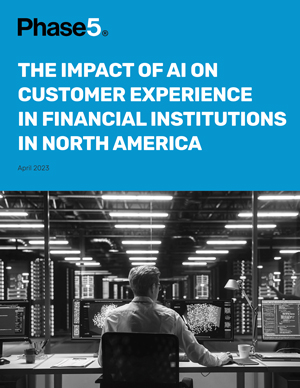 By Arnie Guha
By Arnie Guha
The rapid development of AI technology has significantly impacted various industries, including financial services. In the financial sector, AI has the potential to revolutionize customer experience by providing personalized, efficient, and cost-effective services. The adoption of AI technology can also help financial institutions remain competitive and enhance their customer base. Through our work at Phase 5, we have seen several success stories as well as untapped opportunities.
One of the significant advantages of AI in the financial sector is providing personalized financial products and recommendations. Financial institutions can analyze customer data and offer tailored solutions based on a customer’s specific needs, goals, and financial situation. For instance, banks can use AI-powered chatbots to provide personalized financial advice and automate investment recommendations. This not only enhances the customer experience but also improves financial outcomes for customers. Moreover, AI can help to make financial products more accessible and affordable to customers. By automating certain processes, such as underwriting and risk assessment, financial institutions can reduce the costs associated with offering financial products, allowing them to offer products at a lower cost to customers. This can be particularly beneficial to underserved populations that may not have access to traditional banking services.
Intelligent automation, which includes artificial intelligence (AI), business process management (BPM), and robotic process automation (RPA) can significantly improve the efficiency of financial institutions while reducing costs. By automating routine and repetitive tasks, such as data entry and customer service, staff can focus on higher-value tasks, such as analyzing data and providing personalized recommendations to customers. This results in a better customer experience as staff can provide more time and attention to customers. It also reduces operational costs for financial institutions. In addition, intelligent automation can help improve compliance and regulatory reporting, reducing the risk of non-compliance and associated penalties. AI can also help financial institutions identify and respond to potential issues and threats, such as fraud and security breaches, in real time, improving security and protecting customer data.
In addition to providing 24/7 customer support and reducing wait times, AI can also automate loan and mortgage applications, reducing the time and effort required from both customers and bank staff. By using AI algorithms to analyze financial and personal data, financial institutions can make lending decisions in real time, providing customers with faster and more convenient loan approvals. During the COVID-19 pandemic, TD Bank deployed AI technology to assist customers by launching digital nudges to those who were more likely to be financially vulnerable. The AI system used more than 100 variables, including account balance and transaction patterns, to identify customers who could benefit from financial relief and support programs. These customers received nudges directing them to TD’s COVID-19 support page and government resources. The bank is now fully integrating AI within its app to provide customers with a personalized experience based on their transaction patterns.
The use of AI in financial services does raise important ethical considerations, particularly around issues of privacy and bias. Financial institutions must ensure that they are transparent in how they collect and use customer data and that they are not discriminating against certain groups of customers based on factors such as race, gender, or age. Additionally, financial institutions must ensure that AI algorithms are not perpetuating or amplifying existing biases in financial decision-making, such as systemic discrimination against certain groups. The potential risks associated with biased or discriminatory AI algorithms can have far-reaching consequences for a company’s reputation, regulatory compliance, and legal liabilities. To address these risks, companies must develop and implement clear ethical guidelines for their AI systems, starting from the earliest stages of development. This includes implementing mechanisms for transparency and explainability of AI decision-making, as well as establishing independent oversight and accountability structures to ensure compliance with ethical standards. By prioritizing ethical AI practices, companies can not only mitigate risks but also build trust with customers, regulators, and the broader public.
AI has the potential to transform the customer experience in financial institutions in North America by providing personalized financial products, improving efficiency, enhancing security and fraud detection, and improving customer service. However, there are important ethical considerations that financial institutions must address to ensure that AI is used in a responsible and equitable manner. By addressing these considerations proactively, financial institutions can enhance customer trust and confidence in AI-powered financial services. Research can help define and assess your customers’ needs and pain points, enabling you to strategically prioritize technological enhancements and intelligently allocate scarce resources for maximum impact. Contact us to discuss how Phase 5 can support your organization’s journey to customer-centricity through the informed and responsible application of AI capabilities.
For additional information, please visit www.phase-5.com
 An Interview with Arnie Guha – Author
An Interview with Arnie Guha – Author
By Michael Brooke
The report that you’ve just read opens up an enormous amount of questions. I had the opportunity to interview its author, Arnie Guha. My first question surrounded the subject matter — “Why banks?” As Arnie explains, “The reason I chose banks was that there are two types of institutions that touch almost everyone in modern society. One is the various levels of government and the other is financial institutions. No matter who you are or what you do, these two institutions will have some effect on your life.”
Most Canadians have a curious relationship with their banks. “There really are very different perceptions about banks when we compare the US to Canada. The Schedule One banks in Canada have a very high level of trust. The US is, of course, a different story. Even so, people in Canada do like to complain about banks. One of their biggest complaints is ‘Why are you charging me when you are keeping my money?’” Customers are concerned when a branch shuts down because they perceive the bank is reducing costs by cutting staff. “They see the reduction in bricks-and-mortar costs but don’t see the cost of employing technology to provide services and they don’t see any savings passed on to them,” says Arnie. As he sees it, the banks have not really explained the fact that technology costs money. Or how the same technical infrastructure might support transactions across multiple channels: for instance, when a customer visits a branch, they deal with human agents who are all working off an online system; but many people don’t see the technology at work, which leads them to make false assumptions about the relative safety of bricks-and-mortar transactions, compared to conducting the same transactions online. Explaining the role of technology, as well as security protocols in place to protect customers, would go a long way toward addressing misconceptions.
Arnie was quick to point out that AI can be enormously positive for both banks and their customers. “AI can give banks an opportunity to reduce costs. But with AI mimicking the idiom and cadence of human communication, , I think the customer experience can become that much more personal”. Some of the institutional brusqueness that customers occasionally feel will recede as AI delivers a much more personable experience. “I can see customers asking about fees with a highly advanced AI chatbot. In this context, rapport can be built which will deliver the messages in a far more reassuring and resonating way.”
AI has the potential to shift the transactional nature of routine queries (e.g., about account balances) to a more conversational relationship. In this context, a query about an account balance can lead to a conversation about how and how much to save and (where compliance allows) AI-powered analysis of customer spend-behaviour and associated recommendations (needless to say, this can easily be tied to cross-promotion of various products). This creates an environment in which AI is now encouraging customers when they stick to their financial goals and offers gentle nudges when they see someone has gone over budget.
At this point, AI is still an emerging technology within financial institutions. “We haven’t let the tap run that long, so it’s hard to really gauge the cumulative psychological or emotional impact this is having on the brand,” says Arnie. “If the bank is talking to me in a way that I find reassuring, my relationship with this institution changes and an even greater level of trust is created. This creates a whole new relationship.”
Arnie believes that it’s natural for people to be in awe of the conversations that AI can create, but sometimes we forget an even bigger consequence of this technology. “When our relationship with AI becomes conversational and has its own dynamic, it changes what we feel about the institution.” This has profound repercussions on CX. “Right now, there are customers who, for whatever reason, feel uncomfortable contacting their bank. But if AI becomes their way of communication and they begin to feel their needs are being met, then maybe they’ll form a habit of doing just that.”
Successful deployment of AI is about understanding and negotiating the hierarchy of intent and agency. “It’s a tool and the question is: where does it fit within the CX framework?” says Arnie. It’s vital to determine where and when AI can be injected so that it does the most good. “Where are those points of maximum and acceptable agency?”
When it comes to AI and bias, Arnie believes that it will take time for things to sort themselves out. “As AI learns, it will change. But I don’t think bias will ever be completely removed. Bias, like energy, just simply shifts. It shifts — will shift — in the direction that we want it to go.”
As for the future, Arnie explains that when the shift in our relationship with our banks takes place, then AI holds the potential for a very positive impact on the lives of specific populations. “I am looking at how AI can help vulnerable members of society. If someone is financially falling behind, then the bank could approach that customer using AI. They would have a conversation that is both a partial nudge and partly a recommendation.” Going beyond this, AI can potentially connect dots and deliver insights that front-line customer service representatives are not able to (for various privacy and compliance reasons): for instance, if a customer calls a bank, a human agent might have very restricted access to the customer’s specific financial information. But in a scenario where an AI-enabled algorithm has access to a customer’s information across multiple databases, the same customer might receive unique insight that would otherwise be unavailable. “Permission for AI to join certain dots, to give customers a particular unique response, in a relatable communicative idiom and cadence, will probably be the biggest impact on financial institutions.”




